![]() Planning to upgrade to Outlook 2013? This guide contains a lot of preparation and other information to get yourself ready before you double click on that setup.exe file.
Planning to upgrade to Outlook 2013? This guide contains a lot of preparation and other information to get yourself ready before you double click on that setup.exe file.
Aside from the preparation steps, this guide informs you about what to expect when you start Outlook 2013 for the first time after you upgraded and how to troubleshoot several issues you may encounter during or after the installation.
Furthermore, for those of you who need some transition time, you’ll find a Ribbon-Customization-file in this guide to make the Outlook interface look similar to the one found in Outlook 2007.
- Supported versions of Windows
- Supported versions of Exchange
- Choosing between 32-bit and 64-bit
- Special notice for Outlook Hotmail Connector accounts
- Uninstall any previous version first
- Installing Outlook/Office 2013
- Installing or upgrading Business Contact Manager
- Starting Outlook for the first time after the upgrade
- Migrating nk2-file/AutoSuggest
- Upgrading from Outlook 2002/XP or previous
- Ribbon Classic view
- Outlook 2013 compatibility with previous versions of Office
- Outlook 2013 standalone installations
Tip!
Have you already successfully upgraded to Outlook 2013?
The you might enjoy the guides 30 Short questions and tips for Outlook 2013 and Where do I find…? instead.
Supported versions of Windows
In order to install Outlook 2013, you’ll need at least the following version of Windows and Service Pack level:
- Windows 7 SP1 (32-bit or 64-bit)
- Windows 8 (32-bit or 64-bit)
If you want to use Outlook 2013 on a server version of Windows you can use:
- Windows Server 2008 R2 SP1 (64-bit)
- Windows Server 2012 (64-bit)

Right click on “Computer” in the Start Menu or Explorer and choose Properties to see which Windows Service Pack you have installed. Another way to see it is via: Control Panel-> System and Security-> System
Trying to install Office 2013 on Windows XP or Windows Vista will result in the error:
The specified program requires a newer version of Windows.
Supported versions of Exchange
If you are making use of an Exchange account, the Exchange server has to be one of the following versions. Earlier versions of Exchange are not supported.
- Exchange 2007
- Exchange 2010
- Exchange 2013
Tip!
To find out which version of Exchange you are connecting to now see this Quick Tip.
Notable features requiring at least Exchange 2010
- Integrated e-mail archive; designed to replace the pst-archive for corporate environments
- MailTips; Configurable warning system to prevent common e-mail mistakes
- Connecting to multiple Exchange servers is only supported when all the servers are running Exchange 2010
- Greater Calendar reliability
- Improved retention and compliance functionality.
Notable features requiring at least Exchange 2013
- Site Mailboxes; a new sharing and collaboration mailbox to unite mailbox data and stored documents (also requires SharePoint 2013).
- Policy Tips; an extension of the MailTips feature to inform you that you might be sending out sensitive information (within Exchange this is knows as Data Loss Prevention or DLP).
- Mail Apps; a new way to add (external web) services and extensions to Outlook which are managed on the Exchange server rather than on the local Outlook client via an add-in.
Note:
In order to use some of the functionality in Outlook 2013, you’ll require configuring your Exchange account with Cached Exchange Mode enabled (CEM). This is similar to Outlook 2010. For an overview of features requiring CEM see: Outlook 2010: New features and Cached Exchange Mode
Choosing between 32-bit and 64-bit
All Office 2013 applications are available in both a 32-bit and a 64-bit edition. The 64-bit version can only be installed on a 64-bit version of Windows. The 32-bit version can be installed on both a 32-bit and a 64-bit version of Windows.
Benefits of using the 64-bit edition of Outlook 2013
Using the 64-bit version of Outlook does not have any direct benefits. The functionality within Outlook is the same and there is also no (noticeable) performance increase by using the 64-bit edition.
Installing the 64-bit version only really makes sense when you also need the 64-bit version of Excel for large file support (>2GB) and/or several complex calculations.
If you do not use these 64-bit specific features, Microsoft recommends that you use the 32-bit version instead. Unless you specifically choose otherwise, the installer will automatically install the 32-bit version of Outlook even when your system supports the 64-bit edition (further details are discussed later in this article).
Downsides of using the 64-bit edition of Outlook 2013
If you choose for the 64-bit version, you’ll have to be aware of the following downsides;
- All add-ins that you want to use have to be recompiled as 64-bit add-ins by the vendor of these add-ins. You can contact the vendor of the add-in to verify if they supply 64-bit versions of their add-ins and if you are eligible for a free upgrade.
- Many sync applications for mobile phones and other mobile devices will not recognize the Outlook installation. These sync applications will require an update as well. Microsoft has announced that Windows Mobile Device Manager (WMDC) will not be updated for Outlook 64-bit compatibility. When you try to sync with Outlook 2013 64-bit, you’ll receive the following error;
“Either there is no default mail client or the current mail client cannot fulfill the messaging request” - Messaging Application Programming Interface (MAPI) calls can only be made at the 64-bit level. If you have an application which integrates with Outlook at MAPI level, this integration is lost when this is a 32-bit application. A common example is the integration with Microsoft Office Communicator as this is currently only available as a 32-bit application.
- Custom solutions which make use of existing ActiveX controls will not work and will require an update or rewriting.
- Existing Custom VBA solutions may not work when they contain the Declare statement and will require rewriting.
Note:
While every add-in requires an update for compatibility with the 64-bit version of Outlook 2013, many 32-bit add-ins might require an update as well. You can check with the vendor of the add-in to verify its compatibility. If you run into issues with Outlook after the upgrade, start with disabling your add-ins.
Note!
Are you using Microsoft’s Personal Folders Backup Add-in? You’ll find it no longer working with Outlook 2013. Currently, there is no workaround available for this. You can choose to backup your pst-files manually, include them in other backup schedules which you have configured already.
Special notice for Outlook Hotmail Connector accounts
If you are using Outlook with a Hotmail/Outlook.com account configured via the Outlook Hotmail Connector, then your accounts will automatically be migrated to use the “Exchange Active Sync” (EAS) protocol instead.
EAS is the new method of connecting to Hotmail/Outlook.com accounts in Outlook and also offers support for synching your Tasks.
Important!
During this migration process, any data that you kept in Outlook Hotmail Connector folders which do not synch via the Outlook Hotmail Connector will be lost. These folder are marked in the Folder List Navigation (keyboard shortcut CTRL+6) with “This computer only” such as the Tasks and Notes folder. Make sure you export or copy these folder to a pst-file before upgrading.
After the upgrade and migration process, you can uninstall the Outlook Hotmail Connector from your computer as Outlook 2013 does no longer use it.
For additional information see: Manually migrate Outlook Hotmail Connector features and settings to Outlook 2013
Uninstall any previous version first
Only a single version of Outlook can be installed at a time on a computer. When installing Office 2013 while a previous version of Outlook is still installed, Outlook 2013 will be installed and the previous version of Outlook will be removed; even when you select to keep the previous versions.
If you do not plan to use any of the Office applications of a previous version of Office, it is recommended to completely uninstall the Office suite before starting the installation process of Office 2013. This is because an upgrade process will still leave several (support) components installed.
If you only want to install Outlook 2013 and combine it with Office applications of previous versions of Office see this section later in this guide (Outlook 2013 compatibility with previous versions of Office).
If you currently have Consumer Preview or Office 365 Home Premium Preview of Office 2013 installed, you’ll have to first uninstall any Office 2013 Preview application before you can install the released version of an Office 2013 application. Upgrading from a Preview release is not supported.
Note:
When uninstalling Office, you will not lose any settings or Outlook data and settings will still be automatically upgraded. It of course never hurts to make a backup of your Outlook data first.
If you are having difficulties removing your current version of Office via Control Panel, you can use the FixIt from the Microsoft KB article below which matches with the version that you wish to uninstall:
- Uninstall Microsoft Office 2013 or Office 365 (including the Preview releases)
- How to uninstall or remove Microsoft Office 2010 suites
- How to uninstall or remove Microsoft Office 2007 suites
- How to uninstall or remove Microsoft Office 2003 suites
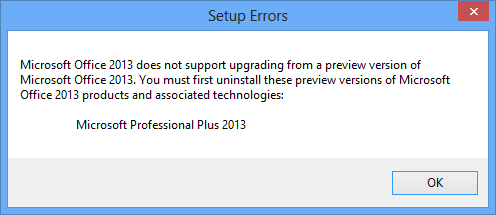
Installing Office 2013 while the Preview release is still installed is not possible.
Installing Outlook/Office 2013
Now that your machine has been prepared, you can run the installer to install Office 2013. By default, it will install the 32-bit version unless you specifically tell it not to. If the 32-bit version is what you want (again; this is recommended), then just follow the setup instructions and move to the next section in this guide. If you want to install the 64-bit version, keep reading…
In order to install the 64-bit version of Outlook 2013, you must make sure that no previous version of Office still is installed on your computer and also that there are no 32-bit applications of Office 2013 still installed. If any such application is still installed, you will not be able to install the 64-bit version of Outlook.
When you start Setup from an installation medium that has both the 32-bit and the 64-bit version on it, you’ll be installing the 32-bit version of Outlook by default. When you press the Customize button in Setup, you’ll see the Platform tab if your system can support a 64-bit installation of Outlook 2013.
If it does, and you want to start installing it, you must close the current Setup window and browse to the installation source (for instance on the CD or DVD-drive). Here you’ll find a folder called x64. Open it and run the setup.exe file located in this folder. The setup process is further the same as for the 32-bit version of Outlook.
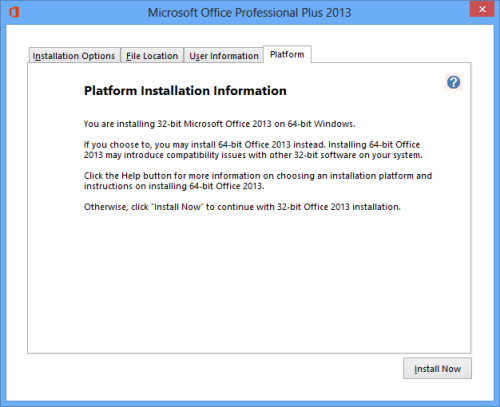
Installation Information about the availability of the 64-bit version of Office 2013.
(click on image to enlarge)
Installing or upgrading Business Contact Manager
If you were using Outlook Business Contact Manager (BCM), then you’ll also need to update BCM before starting Outlook 2013.
There are 2 updated BCM packages that have been released for BCM. One is for if you were already using BCM with Outlook 2010. The other one is for when you were already using BCM with Outlook 2007 or when you are doing a clean installation (or were not yet using BCM).
Download: Compatibility update for Business Contact Manager 2010 (update only)
Download: Business Contact Manager for Microsoft Outlook 2013 and Outlook 2010 (full)
Starting Outlook for the first time after the upgrade
When you start Outlook for the first time after the upgrade, the startup could take some time. This is because your previous settings are being migrated.
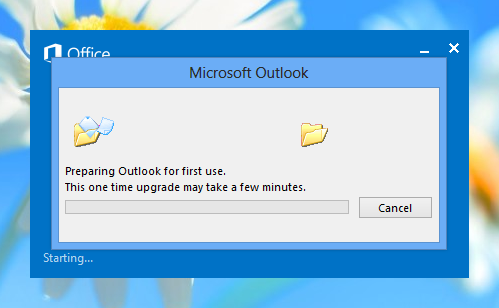
Mail profiles are upgraded on startup and some accounts will be re-cached.
If you are upgrading from a version earlier than Outlook 2007 Service Pack 2, then several extensive file structure changes to the pst-file are being made which could take a lot of time (especially with a large pst-file). Upgrading from a later version usually goes a lot quicker.
When the processing is being performed in the background, Outlook notifies you with a Notification Bar at the top in your main Outlook Window. If you close this Notification Bar, then you can also press on the File button to monitor the progress in Backstage

The “Upgrade in progress” notification is shown when a conversion is still taking place in the background. (click on image for full notification message)
Re-caching and recreation of mailboxes
- If you are using an Exchange account, then your mailbox will be re-cached to a new compacter format ost-file.
- If you are using an IMAP account, then your mailbox will also be re-cached in an ost-file rather than a pst-file. If your Sent Items and other default mailbox folders are mapped incorrectly see: Setting the Sent Items folder for IMAP accounts in Outlook 2013.
- If you are using an Outlook Hotmail Connector account, then you account will be automatically recreated as an Exchange Active Sync (EAS) account. This is also accompanied by a re-cache of your mailbox in an ost-file (make sure you’ve read the special notice above for more details to prevent data loss).
Note:
While upgrading from a previous version of Outlook will automatically upgrade your mail profile, it still is recommended to recreate you mail profile.
Especially when you are using a version earlier than Outlook 2010 or when using Outlook with an IMAP account, recreating your mail profile is really recommended due to deep level changes to multi-account and IMAP support and configurations.
Migrating nk2-file/AutoSuggest
Outlook 2002/XP, Outlook 2003 and Outlook 2007 make use of an nk2-file to store recently used addresses in which are used as an AutoSuggest/AutoComplete feature when addressing a new message. Outlook 2013 no longer uses an nk2-file for caching but stores these addresses in the Suggested Contacts folder in the Outlook mailbox itself.
When you upgrade to Outlook 2013, the nk2-file is automatically imported upon starting Outlook 2013 for the first time. When you create a new Outlook mail profile or when using Outlook on a new computer, you can import an existing nk2-file in the following way;
- Copy the nk2-file to the following folder;
C:\Users\%username%\AppData\Roaming\Microsoft\Outlook
- Rename the nk2-file to the name of your mail profile.
To find out this name use the Mail applet in Control Panel and click on the Show Profiles… button.
By default, your profile is called “Outlook”. So in that case you would call your file “outlook.nk2”. - Start Outlook with the /importnk2 switch;
- Windows 7
Start-> type;outlook.exe /importnk2 - Windows 8
Open the Start Screen-> type;outlook.exe /importnk2
(just start typing, a search field will automatically appear)
- Windows 7
- Outlook will now process the nk2-file and import it into the Suggested Contacts folder. Outlook will automatically append .old to the nk2-file. So in our example it will now be called; outlook.nk2.old
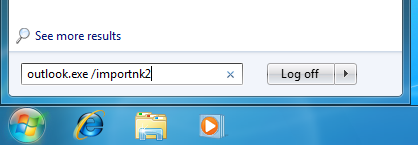
Importing the nk2-file in Outlook 2013 on Windows 7.
Tip!
ABF Outlook Backup (discount code: ABF-HT2GL ) is fully compatible with Outlook 2010 and supports migrations from previous versions of Outlook and Windows to a new version, even on a new computer.
Upgrading from Outlook 2002/XP or previous
When upgrading from Outlook 2002/XP or previous to Outlook 2013, then aside from starting with a new mail profile, it is also recommended to start with a new pst-file. This is because since Outlook 2003, the pst-file format has changed from an ANSI format to a Unicode format. The benefit of this new file format is international character support and the 2GB file size limit no longer exists.
Creating an Unicode pst-file
Upgrading your pst-file from ANSI to Unicode format goes easiest when you also have started with a new mail profile. In that case you can reconnect to your original ANSI pst-file via;
File-> Open-> Open Outlook Data File…
If you did not start with a new mail profile, then you can create a new pst-file and set it as the default;
- Create a new pst-file;
New Items-> More Items-> Outlook Data File… - Set it as the default;
File-> Account Settings> Account Settings…-> tab Data Files-> select your newly created pst-file-> button Set as Default - Restart Outlook
Moving all your data
After you’ve created a new Unicode pst-file, you can copy over all your messages and folders from the old pst-file to the empty new one.
To move your Calendar items all at once, you can switch your Calendar view to a table layout via;
tab View-> button Change View-> List
You can now move your appointments and meetings just like you move your email messages.
Disconnect the old pst-file
When done moving/copying, you should disconnect the old ANSI formatted pst-file. Before you do this, make sure none of your email accounts are still set to deliver to this pst-file. You can do this via;
- File-> Account Settings-> Account Settings…
- Select an account and check its delivery location exposed at the bottom. This should no longer point to the old pst-file.
- Check this for each configured account and then switch to the Data Files tab.
- Select the old pst-file and click on the button Remove.
- Close Outlook to complete the disconnection. Optionally, you can delete the old pst-file to free up some disk space.
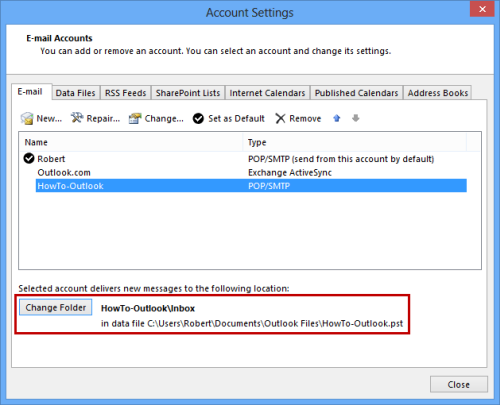
Verify that the delivery location of an account is not still pointing to an old pst-file.
(click on image to enlarge)
Ribbon Classic view
Just like Outlook 2010, Outlook 2013 no longer uses Toolbars and Menus in the main interface but now also uses the Ribbon. If you are heaving issues with finding your favorite options in the new interface, you can use the guide: Where do I find…?.
Outlook does not ship with a classic interface built-in to mimic the interface of Outlook 2007 and previous. For people having difficulties to quickly adapt to the new interface and to support migration projects, I’ve created a customized Ribbon which looks like the Office 2007 interface.
Download: Classic Ribbon tab for Outlook 2010 and Outlook 2013
You can add the Classic tab in the following way;
- Download and extract the zip-file.
- Open the Options dialog in Outlook via; File-> Options
- Select the “Customize Ribbon” section on the left.
- Use the Import/Export button at the bottom right to select “Import customizations file”.
- Browse to the folder where you extracted the zip-file.
- You’ll now see 3 files;
classic.customUI
This customizations file will only show the Classic tab and will hide all others.classic-firsttab.custumUI
This customizations file will add the Classic tab as the first before all the default tabs.classic-lasttab.customUI
This customizations file will add the Classic tab as the last tab after all the default tabs.
- Pick one of the files and click on “Open” to return to the Options dialog.
- Click on OK to close the Options dialog and to return to Outlook.

Adding a Classic interface to Outlook 2013 with Menus and Toolbars.
(click on image for a full view of the Classic tab)
Note:
Due to Ribbon limitations and feature changes, the Classic Ribbon tab is not an exact replica but a close approximation of the menu and toolbars in Outlook 2007.
Outlook 2013 compatibility with previous versions of Office
While you cannot have multiple version of Outlook installed on the same machine, Outlook 2013 can co-exist with previous versions of other Office applications on the same computer. There are a couple of side-notes though;
Attachment Previewers
Attachment Previewers for other Office applications will only work when the other Office applications are the 2013 versions as well. The previewers of the 2007 and 2010 versions of Word, Excel and PowerPoint are not compatible with Outlook 2013.
Mail Merge
Just with any previous versions of Outlook, the Mail Merge feature only works when Word and Outlook are the same version.
Outlook 2013 standalone installations
Outlook 2013 can be installed without needing to upgrade all the other Office applications. However, not all features might be available to you. Similar to Outlook 2007 and Outlook 2010, the following features require you to install Word 2013 as well;
- Autoformat
- AutoText
- Background spelling
- Synonym lookup
- On-Object UI (including Smart Paste)
- Data binding and placeholders
- Grammar checker
- Smart tags
- Tables formatting
- Various “Save As” formats specific to Word
- Go To tab of the Find/Replace feature
- Citation and bibliography
- Header and footer
- Review and comments
- Captions (for tables and images)
- WordArt
- Insert Screen Clipping/Screenshot
- Access to the Word Object Model (for macro usage for example)
Tip!
To get Automatic spell check and Autocorrect working when you have Outlook 2013 without Word 2013 installed, you can use the following workaround: Automatic spell check and Autocorrect not working
Outlook Standalone version and Themes
Similar to Office 2007 and Office 2010, the Themes feature requires Outlook to be installed as part of a suite. A combination of Office 2013 Home & Student with a standalone installation of Outlook 2013 will not enable this feature.
You can find the Theme feature via;
File-> Options-> section Mail-> button Stationery and Fonts…


